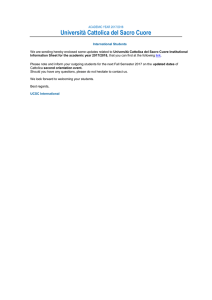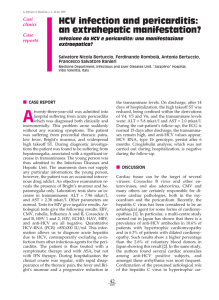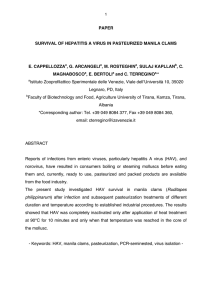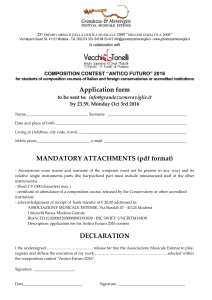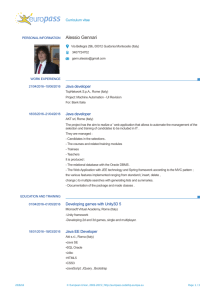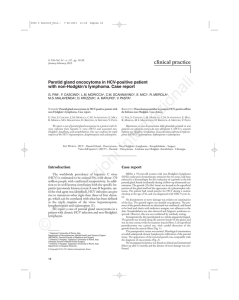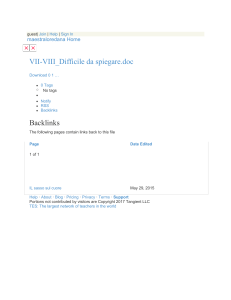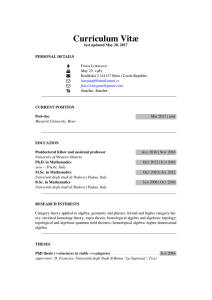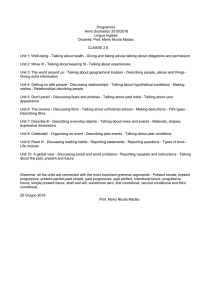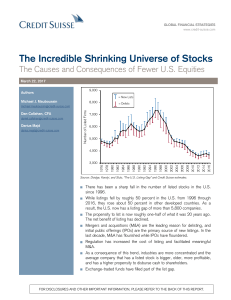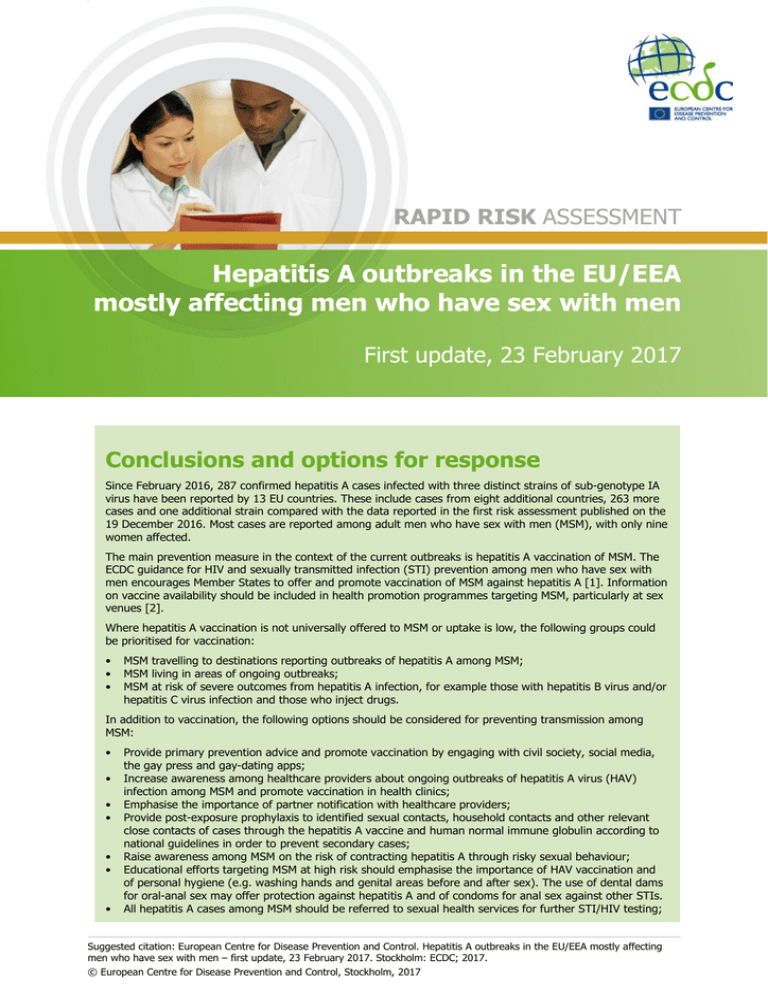
z
RAPID RISK ASSESSMENT
Hepatitis A outbreaks in the EU/EEA
mostly affecting men who have sex with men
First update, 23 February 2017
Conclusions and options for response
Since February 2016, 287 confirmed hepatitis A cases infected with three distinct strains of sub-genotype IA
virus have been reported by 13 EU countries. These include cases from eight additional countries, 263 more
cases and one additional strain compared with the data reported in the first risk assessment published on the
19 December 2016. Most cases are reported among adult men who have sex with men (MSM), with only nine
women affected.
The main prevention measure in the context of the current outbreaks is hepatitis A vaccination of MSM. The
ECDC guidance for HIV and sexually transmitted infection (STI) prevention among men who have sex with
men encourages Member States to offer and promote vaccination of MSM against hepatitis A [1]. Information
on vaccine availability should be included in health promotion programmes targeting MSM, particularly at sex
venues [2].
Where hepatitis A vaccination is not universally offered to MSM or uptake is low, the following groups could
be prioritised for vaccination:
•
•
•
MSM travelling to destinations reporting outbreaks of hepatitis A among MSM;
MSM living in areas of ongoing outbreaks;
MSM at risk of severe outcomes from hepatitis A infection, for example those with hepatitis B virus and/or
hepatitis C virus infection and those who inject drugs.
In addition to vaccination, the following options should be considered for preventing transmission among
MSM:
•
•
•
•
•
•
•
Provide primary prevention advice and promote vaccination by engaging with civil society, social media,
the gay press and gay-dating apps;
Increase awareness among healthcare providers about ongoing outbreaks of hepatitis A virus (HAV)
infection among MSM and promote vaccination in health clinics;
Emphasise the importance of partner notification with healthcare providers;
Provide post-exposure prophylaxis to identified sexual contacts, household contacts and other relevant
close contacts of cases through the hepatitis A vaccine and human normal immune globulin according to
national guidelines in order to prevent secondary cases;
Raise awareness among MSM on the risk of contracting hepatitis A through risky sexual behaviour;
Educational efforts targeting MSM at high risk should emphasise the importance of HAV vaccination and
of personal hygiene (e.g. washing hands and genital areas before and after sex). The use of dental dams
for oral-anal sex may offer protection against hepatitis A and of condoms for anal sex against other STIs.
All hepatitis A cases among MSM should be referred to sexual health services for further STI/HIV testing;
Suggested citation: European Centre for Disease Prevention and Control. Hepatitis A outbreaks in the EU/EEA mostly affecting
men who have sex with men – first update, 23 February 2017. Stockholm: ECDC; 2017.
© European Centre for Disease Prevention and Control, Stockholm, 2017
RAPID RISK ASSESSMENT
•
Hepatitis A outbreaks in EU/EEA mostly affecting MSM, 23 February 2017
Hepatitis A cases should be notified to public health authorities and where required, temporarily excluded
from work according to national legislation and guidance.
Sharing of microbiological and epidemiological details of new cases and questionnaires used during outbreak
investigations through the Epidemic Intelligence Information System for Food- and Waterborne Diseases and
Zoonoses (EPIS-FWD) is encouraged for monitoring the epidemiological situation.
Source and date of request
European Commission request for an updated rapid risk assessment, dated 15 February 2017.
Public health issue
Ongoing transmission of hepatitis A virus (HAV) infection mainly affecting men who have sex with men (MSM) in
EU/EEA countries.
Consulted experts
ECDC internal response team in alphabetical order: Erika Duffell, Anke Kohlenberg, Katrin Leitmeyer, Otilia Mardh,
Taina Niskanen, Ettore Severi, Gianfranco Spiteri, Lara Payne-Hallstrom, Therese Westrell.
External experts consulted: Stephan Aberle (Medical University of Vienna, Austria), Franz Allerberger (Austrian
Agency for Health and Food Safety, Austria), Ana Avellon Calvo (Viral Hepatitis Reference and Research
Laboratory, Carlos III Health Institute, Spain), Kazim Beebeejaun (Public Health England, UK), Koye Balogun
(Public Health England, UK), Roberto Bruni (Istituto Superiore di Sanita, Italy), Anna Rita Ciccaglione (Istituto
Superiore di Sanita, Italy), Michael Edelstein (Public Health England, UK), Josefine Ederth (Public Health Agency of
Sweden), Mirko Faber (Robert Koch Institute, Germany), Sofieke Klamer (Scientifique Institute of Public Health,
Belgium), Virginie Maes (Scientifique Institute of Public Health, Belgium), Sofie Elisabeth Midgley (Statens Serum
Institut, Denmark), Luise Mueller (Statens Serum Institut, Denmark), Siew Lin Ngui (Public Health England, UK),
Sophie Quoilin (Scientifc Institute of Public Health, Belgium), Lena Sundqvist (Public Health Agency of Sweden),
Rita de Sousa (National Institute of Health Doutor Ricardo Jorge, Portugal), Caterina Rizzo (Istituto Superiore di
Sanita, Italy), Lelia Thornton (HSE Health Protection Centre, Ireland), Maria Elena Tosti (Istituto Superiore di
Sanita, Italy), Carmen Varela Martinez (Carlos III Health Institute, Spain), Harry Vennema (National Institute for
Pulic Health and the Environment, the Netherlands), Jürgen Wenzel (National Consultant Laboratory for HAV and
HEV, Germany), Dirk Werber (State Office for Health and Social Affairs, Berlin, Germany).
Disease background information
Hepatitis A is an acute, usually self-limiting infection caused by the hepatitis A virus. Transmission is predominately
by the faecal-oral route, through contaminated water or food-products and/or by person-to-person contact.
Transmission through sexual exposure has been associated with outbreaks in men who have sex with men (MSM),
and transmission through sharing of needles and syringes with outbreaks among people who inject drugs.
Parenteral transmission through infected instruments or, rarely, blood components has been documented [3].
The infection is asymptomatic or mild in children, but both the proportion of symptomatic infections and the
severity of the presentation increases with age. Adults may develop jaundice and present with more severe clinical
symptoms. The case-fatality ratio is generally 0.1%, but can be 1.8% in adults >50 years of age and in
immunocompromised patients. The mean incubation period is 28 days, ranging from 15 to 50 days. The maximum
infectivity is in the second half of the incubation period (i.e. while asymptomatic) and most cases are considered
non-infectious after the first week of jaundice. The diagnosis is made by serology or molecular tests. Anti-HAV IgM
serology and detection of HAV-RNA indicate acute infection. Almost all human hepatitis A viruses belong to
genotypes I and III, with genotype I being divided into sub-genotypes IA and IB. Genotype I is the most
prevalent, comprising at least 80% of circulating human strains [4,5].
No specific treatment is available for hepatitis A infection. Strict control measures such as enforcing personal
hygiene, contact tracing and administration of the vaccine to exposed persons have been shown to be effective in
reducing transmission. Active and passive immunisation is effective if administered within two weeks of exposure.
Several inactivated vaccines are available for prevention [6]. Post-exposure prophylaxis should be administered
according to national guidelines.
2
RAPID RISK ASSESSMENT
Hepatitis A outbreaks in EU/EEA mostly affecting MSM, 23 February 2017
In 2015, 12 527 confirmed hepatitis A cases were reported to the European Surveillance System (TESSy) by 30
EU/EEA countries. Romania accounted for 41% of the cases and Bulgaria for 9%. Cases were reported among all
age groups with most cases among 5–14 year-olds (39%) and 25–44 year-olds (19%). Male cases were more
frequent than female ones, particularly in age groups 15–24 and 25–44 years, with a male to female (M:F) ratio of
1.3 and 1.2, respectively. The majority (91%) of infections were acquired in the country of residence. However,
the percentage of travel-associated cases varied from zero to 100% across Europe. Syria, Morocco and Turkey
were the most common travel destinations among travel-associated cases. Among the 479 cases related to travel
within the EU/EEA for the period 2010–2015, the male-to-female ratio was 1.4.
Hepatitis A seroprevalence presents a high degree of temporal and spatial variability across the EU/EEA, with
increasing seroprevalence from northern to central, southern and eastern EU/EEA. The susceptibility to infection
among adults is highest in northern EU/EEA countries and lowest in eastern EU countries. There is an overall
decreasing trend of the seroprevalence over the last four decades in most countries [3]
Outbreaks of hepatitis A among MSM have been recognised since the 1970s [7-10]. Several multinational
outbreaks have been described, one of which involved at least eight cities across three countries and two
continents, North America and Australia, and occurred from January through June 1991[11]. Several European
countries reported national outbreaks in MSM in the past decades. The main risk factor is related to direct oral-anal
contact during sex [12-15]. The current level of immunity among the MSM population in Europe is unknown. It has
been estimated that a level of >70% immunity among the MSM population would prevent sustained transmission
and future outbreaks [16].
Event background information
Descriptive epidemiology
Since the publication of the first RRA on hepatitis A among MSM on 19 December 2016, two additional urgent
inquiries were launched in EPIS FWD, by Germany on 11 January 2017 and by the Netherlands on 31 January
2017. The investigations of these events have identified three separate clusters based on genetic sequencing of
the hepatitis A virus (HAV) (Figure 1). The descriptive epidemiology is presented for each cluster as they probably
indicate separate transmission chains.
Figure 1. Distribution of hepatitis A cases by month of report and genetic sequence, June 2016–
February 2017, EU/EEA (n=179).
Note: 108 cases with missing date of report are not included.
Event 1 – Cluster VRD_521_2016
On 6 December 2016, through an EPIS FWD urgent inquiry, the United Kingdom (UK) reported 15 hepatitis A cases
with onset of symptoms between July and November 2016, infected with an identical viral RNA sequence of
genotype IA, geographically grouped in three clusters in England and one case in Northern Ireland. All cases are
male and most (12/15) identify as MSM. Five cases reported travel to Spain.
3
RAPID RISK ASSESSMENT
Hepatitis A outbreaks in EU/EEA mostly affecting MSM, 23 February 2017
As of 22 February 2017, ten EU Member States have reported 190 cases with an identical virus sequence: Spain
(70, preliminary data), Italy (41), the United Kingdom (30), Germany (17), France (14), Portugal (9), Finland (3),
Ireland (3), the Netherlands (2) and Sweden (1). Seventy-seven (94%) of 82 documented cases are male and 33
of 41 documented cases identify themselves as MSM. The median age of cases is 30.5 years, ranging from 18 to
63 years. Seventeen of the 62 cases with information provided are travel-associated of whom 11 cases travelled to
Spain and two had visited Spain in addition to one or more countries during a trip.
Figure 2. Distribution of cases associated with cluster VRD_521_2016 by reporting country and
month (n=87), June 2016-February 2017, EU/EEA.
Note: Thirty-two cases from Italy and 70 cases from Spain with missing month of report are not included. One travel-related
female case reported by Sweden in March 2016 is not included.
On 21 February 2017, Portugal notified 23 cases diagnosed since December 2016 (week 52) through the Early
Warning and Response System, of which nine have the sequence VDR_521_2016 (14 cases are still under
investigation). The 23 cases are males, 31 years of age on average and 10 are MSM. An increase in the number of
HAV cases has been observed in Portugal in recent years, with 26 cases reported in 2015, 55 cases in 2016
(provisional data) and 48 cases in 2017 as of 21 February, of whom 94% are men (provisional data).
Event 2 – Cluster RIVM-HAV16-090
On 14 October 2016, the Netherlands notified two cases of hepatitis A among MSM who participated in the
EuroPride festival in Amsterdam between 23 July and 7 August 2016 through the Early Warning and Response
System. The cases were infected with an indistinguishable IA genotype sequence, but different from the
VRD_521_2016 cluster. The two individuals visited the same location on 2–3 August 2016 where they reported
engaging in anonymous sexual activities. They developed symptoms on 11 and 15 September 2016, respectively.
The clustering in time and place of the cases, along with an identical viral sequence suggest a person-to-person
transmission through the sexual route, but cannot exclude food or waterborne transmission.
As of 22 February 2017, nine EU Member States have reported 70 cases with an identical virus sequence: 31 cases
in the United Kingdom, ten in the Netherlands, eight in Germany, five in Austria, five in Belgium, five in France,
three in Sweden, two in Italy and one in Spain. Sixty-six of 67 documented cases are male and 44 of 49
documented cases identify themselves as MSM. The median age of cases is 36 years, ranging from 25 to 83 years.
Twenty-four of 61 cases with information provided are travel-associated of which 14 cases reported travelling to
Spain.
4
RAPID RISK ASSESSMENT
Hepatitis A outbreaks in EU/EEA mostly affecting MSM, 23 February 2017
Figure 3. Distribution of cases associated with cluster RIVM-HAV16-090 by reporting country and
month (n=67), June 2016–February 2017, EU/EEA.
Note: Only 5/19 cases with available genotyping information are represented for Belgium in this figure. Two cases from Italy and
one case from Spain missing date of report are not included.
On 20 February, Belgium notified 19 cases of hepatitis A diagnosed since December 2016 through the Early
Warning and Response System among MSM. In addition, several cases occurred in non-MSM (according to the
treating physician) and without a known source. Five of the samples from MSM were typed, and matched the
strain circulating in the Netherlands and linked to the EuroPride-Amsterdam 2016.
Event 3 – Cluster V16-25801
On 11 January 2017, through an EPIS FWD urgent inquiry, Germany notified three clusters of hepatitis A,
predominantly males, reported in Berlin in November and December 2016. Cases were related to the two clusters
described above, but a new cluster was also described that included cases in Munich and Frankfurt since August
2016. The distinct genotype IA was denoted V16-25801.
As of 22 February 2017, seven EU Member States have reported 27 cases with identical virus sequence: 18 cases
in Germany, three in the United Kingdom, two in Italy and one case each in Austria, Denmark, the Netherlands and
Spain. Nineteen of 20 documented cases are male and five identify themselves as MSM. The median age of cases
is 30 years, ranging from 24 to 51 years. Four of 14 cases with information provided, are travel-associated and two
of the four had travelled to Germany.
5
RAPID RISK ASSESSMENT
Hepatitis A outbreaks in EU/EEA mostly affecting MSM, 23 February 2017
Figure 4. Distribution of cases associated with cluster Cluster V16-25801 by reporting country and
month (n=25), June 2016–February 2017, EU/EEA.
Note: One case reported by Italy and one reported by Spain with missing date of report are not included in the figure.
Additional information from national outbreak investigations
Two recent publications on the ongoing outbreaks involving multiple strains in the UK [17] and Germany (Berlin)
[18] complement the information reported in EPIS FWD platform as described above. They report findings from
national outbreak investigations and further describe characteristics of the cases and identify potential drivers of the
outbreaks. The following characteristics were identified among the UK cases: co-infections with sexually transmitted
infections, multiple partners, sex-work, use of sex-on-site premises (saunas, clubs) and dating apps (Grindr, Recon).
Further spread among household contacts of two MSM cases was reported.
Germany has reported 38 cases as of 20 January 2017. Twenty-six of 27 documented cases were unvaccinated or
incompletely vaccinated, 30 of 32 documented cases identified themselves as MSM, one male as heterosexual and
the only female case as having sex with other women. While six cases were potentially infected abroad, the majority
were apparently infected in Germany, probably in Berlin. The risks of spread of HAV strains across Europe due to
the nationally and internationally well-connected MSM scene in Berlin was highlighted in the publication [18].
Microbiological investigation
Cluster VRD_521_2016
The HAV strain VRD_521_2016 of sub-genotype IA is characterised by an identical viral RNA sequence of 505
nucleotides from the VP1/2A region. The UK shared this sequence with the European FWD network and ECDC
informed the STI contact points through EPIS STI. The strain is phylogenetically related to strains derived from
Central/South America, based on analysis of European databases (HAVNET).
Cluster RIVM-HAV16-090
The sequence of HAV strain RIVM-HAV16-090 sub-genotype IA was shared in EPIS FWD and EPIS STI with the
respective networks. The sequence is a 460 nucleotides long fragment from the region VP1/2A according to HAVNet protocol [19]. The sequence is closely related to strains reported by Japan and China, so most probably
originally from Asia. In 2015, the UK detected this sequence in a traveller returning from Hong Kong, China.
Recently, the strain was found to be identical to the strain involved in the ongoing outbreak among MSM in
Taiwan.
The sequence of RIVM-HAV16-090 is only 95.4% similar to the VRD_521_2016, suggesting unrelated transmission
events.
6
RAPID RISK ASSESSMENT
Hepatitis A outbreaks in EU/EEA mostly affecting MSM, 23 February 2017
Cluster V16-25801
The sequence of HAV strain V16-25801 sub-genotype IA was shared in EPIS FWD and EPIS STI by Germany. The
sequence is a 459 nucleotides long fragment from the region VP1/2A according to HAV-Net protocol [19]. The
sequence of V16-25801 is only 96.1% similar to the VRD_521_2016 and 96.5% similar to the RIVM-HAV16-090,
suggesting unrelated transmission events.
ECDC threat assessment for the EU
Between February 2016 and February 2017, 13 EU countries have reported three clusters involving 287 HAV
confirmed cases, associated with three different HAV sequences of genotype IA. Each of these clusters involve
between seven and ten different EU Member States. The extent of these outbreaks is likely to be underestimated,
as reported cases are limited to those attending healthcare facilities and for which sequencing was performed.
Most cases are reported among HAV-unvaccinated adult MSM, with only a few women affected. No cases of
infected food handlers have been reported associated to these events, nor has there been any indication of
associated foodborne transmission. Thus, these clusters are considered mainly propagated by person-to-person
sexual transmission. However, the several reports of household transmission linked to these clusters highlight the
need for early contact tracing and post-exposure prophylaxis to close contacts, in order to avoid infections among
unvaccinated household contacts.
Scientific articles on these clusters published after the ECDC rapid risk assessment of 19 December 2016 further
indicate unvaccinated MSM as the European population group most at risk of being affected by these clusters, and
provide further insight into the high-risk sexual practices associated with HAV transmission. In particular, they
indicate anonymous sex, multiple sex partners, sex-on-premises venues and use of dating apps as factors
associated with these outbreaks.
The multinational dimension of these clusters may be explained by the highly interconnected sexual networks
among MSM in Europe. In at least two EU Member States, the United Kingdom and Germany, secondary cases
have been linked to travel-associated index cases. The circulation of three different HAV genotype IA strains in the
MSM population is likely to be the result of several introductions into these networks.
Further transmission resulting from these clusters may be prevented by vaccination of MSM and post-exposure
prophylaxis in identified contacts. However, limited vaccine availability in some countries may have an impact on
the implementation of such control measures.
7
RAPID RISK ASSESSMENT
Hepatitis A outbreaks in EU/EEA mostly affecting MSM, 23 February 2017
References
1.
European Centre for Disease Prevention and Control. HIV and STI prevention among men who have sex
with men. Stockholm: ECDC; 2015.
2.
European Centre for Disease Prevention and Control. Communication strategies for the prevention of HIV,
STI and hepatitis among MSM in Europe. Stockholm: ECDC, 2016.
3.
European Centre for Disease Prevention and Control. Hepatitis A virus in the EU/EEA, 1975-2014.
Stockholm: ECDC, 2016.
4.
Nainan OV, Xia G, Vaughan G, Margolis HS. Diagnosis of Hepatitis A Virus Infection: a molecular approach.
Clin Microbiol Rev. 2006 Jan;19(1):63-79.
5.
Costa-Mattioli M, Di Napoli A, Ferre V, Billaudel S, Perez-Bercoff R, Cristina J. Genetic variability of hepatitis
A virus. J Gen Virol. 2003 Dec;84(Pt 12):3191-201.
6.
Plotkin SA, Orenstein WA, Offit PA, editors. Vaccines, 6th Edition: Elsevier Inc; 2012.
7.
Corey L, Holmes KK. Sexual transmission of hepatitis A in homosexual men: incidence and mechanism. N
Engl J Med. 1980 Feb 21;302(8):435-8.
8.
Hoybye G, Skinhoj P, Hentzer B, Faber V, Mathiesen L. An epidemic of acute viral hepatitis in male
homosexuals. Etiology and clinical characteristics. Scand J Infect Dis. 1980;12(4):241-4.
9.
Mindel A, Tedder R. Hepatitis A in homosexuals. Br Med J (Clin Res Ed). 1981 May 23;282(6277):1666.
10.
Dritz SK, Ainsworth TE, Back A, Boucher LA, Garrard WF, Palmer RD, et al. Patterns of sexually transmitted
enteric diseases in a city. Lancet. 1977 Jul 02;2(8027):3-4.
11.
Centers for Diseases Control and Prevention. Hepatitis A among homosexual men in United States, Canada,
and Australia. MMWR 1992, 155:161-4.
12.
Sfetcu O, Irvine N, Ngui SL, Emerson C, McCaughey C, Donaghy P. Hepatitis A outbreak predominantly
affecting men who have sex with men in Northern Ireland, October 2008 to July 2009. Euro Surveill. 2011
Mar 03;16(9).
13.
Tortajada C, de Olalla PG, Diez E, Pinto RM, Bosch A, Perez U, et al. Hepatitis a among men who have sex
with men in Barcelona, 1989-2010: insufficient control and need for new approaches. BMC Infect Dis. 2012.
14.
Bordi L, Rozera G, Scognamiglio P, Minosse C, Loffredo M, Antinori A, et al. Monophyletic outbreak of
Hepatitis A involving HIV-infected men who have sex with men, Rome, Italy 2008–2009. J Clin Virol. 2012
5//;54(1):26-9.
15.
Mazick A, Howitz M, Rex S, Jensen IP, Weis N, Katzenstein TL, et al. Hepatitis A outbreak among MSM
linked to casual sex and gay saunas in Copenhagen, Denmark. Euro Surveill. 2005 May;10(5):111-4.
16.
Regan DG, Wood JG, Benevent C, Ali H, Smith LW, Robertson PW, et al. Estimating the critical immunity
threshold for preventing hepatitis A outbreaks in men who have sex with men. Epidemiol Infect [Internet].
2016 May; 144(7):[1528-37 pp.]. Available from: https://www.ncbi.nlm.nih.gov/pubmed/26566273.
17.
Beebeejaun K, Degala S, Balogun K, Simms I, Woodhall SC, Heinsbroek E, et al. Outbreak of hepatitis A
associated with men who have sex with men (MSM), England, July 2016 to January 2017. Euro Surveill.
2017 Feb 02;22(5).
18.
Werber D, Michaelis K, Hausner M, Sissolak D, Wenzel J, Bitzegeio J, et al. Ongoing outbreaks of hepatitis A
among men who have sex with men (MSM), Berlin, November 2016 to January 2017 - linked to other
German cities and European countries. Euro Surveill. 2017 Feb 02;22(5).
19.
National Institute for Public Health and the Environment (RIVM). Ministry of Health WaS. Molecular
detection and typing of VP1-2A region of Hepatitis A Virus (HAV). [Protocol]. Bilthoven: RIVM. Available
from: http://www.rivm.nl/en/Topics/H/HAVNET/Protocols/Typing_protocol_HAVNET_VP1P2A.org.
8

